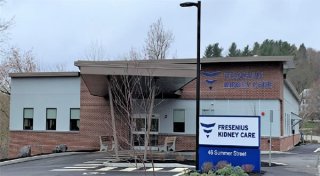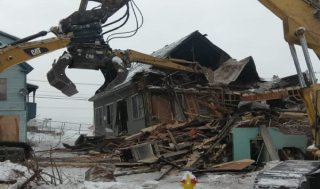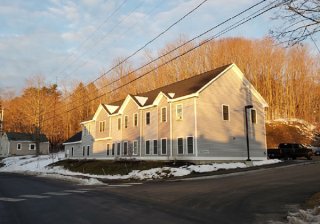R1 Success Story: TW Dick, Gardiner, Maine

EPA Grant Recipient:
City of Gardiner
Grant Types:
Cleanup, Assessment, Revolving Loan Fund
Current Use:
Medical Facility, Residential
Former Uses:
Industrial, Steel Fabrication, Machine Shops, Blacksmith Shops, Woodworking, Shoe Factory, Lumber Sheds, Warehouse
Download Success Story:
TW Dick Gardiner, Maine (pdf)
A former industrial mill site along a stream that powered numerous industries in the 1800s in Gardiner, Maine, has been redeveloped into a new medical facility and housing. This successful redevelopment highlights the great potential for unused mill sites along Cobbosseecontee Stream in this city of 6,000 people just ten 10 minutes from the state capital. The City of Gardiner partnered with EPA, the state of Maine, and the Kennebec Valley Council of Governments to get the site cleaned up and ready for this exciting redevelopment while addressing the needs of the community.
Site History
The TW Dick site is located in the heart of downtown Gardiner, which is known for its culture and New England architecture. Once a thriving industrial city powered by the stream, Gardiner has experienced a slow decline in the past 50 years. The stream corridor in the 1800s supported a dozen industrial mills, using its 100‐foot change in elevation of water to power industrial equipment. In 1860 alone, it powered thirty‐one businesses where over 400 employees generated over $2 million dollars of products. TW Dick was one of the mills that lined the lower portion of the stream, using hydro power for its steel fabrication facility. The 2.9‐acre site included a cold storage warehouse, office building, and steel fabrication building. From the 1800s through 1960, the site was occupied by various foundries, blacksmith shops, wood workers, machine shops, a shoe factory, and lumber sheds. These industrial and commercial uses ceased by 2012, leaving behind a vacant site contaminated with petroleum, asbestos, volatile organic compounds, polycylic aromatic hydrocarbons, and lead.
Priming the Property for Redevelopment

The city took ownership of the TW Dick site through tax foreclosure in 2014, inheriting the responsibility to clean up the contaminants. This acquisition allowed the city to be eligible for EPA Brownfields funding. The city used some of the EPA funding from its 2013 community‐wide assessment grant to determine the nature and extent of the contamination. It also hosted a series of charettes to help the community visualize what "could be" for the Cobbosseecontee Corridor, including the TW Dick site. Local business owners, residents, city staff, EPA, and the Maine Department of Environmental Protection were all involved in the process. Landscape architecture students from the University of Maine created renderings and scale models of concepts developed during the charettes focusing on new urban housing and commercial development.
The city applied for and received a $200,000 cleanup grant in 2016 to help address contamination and clean the site so it could be redeveloped. It also secured additional EPA cleanup dollars through revolving loan funds administered by the Kennebec Valley Council of Governments and the Maine Department of Economic and Community Development. Before buildings were demolished, asbestos, chemicals, and other wastes lingering on the site were removed. A combination of building foundations, paved parking areas, and other protective surfaces were installed to safely cap lower‐level residual contamination beneath the surface. The cleanup was completed and certified by Maine DEP in 2020.
| City of Gardiner Assessment Grant | $70,000 |
| City of Gardiner Cleanup Grant | $200,000 |
| Kennebec Valley Council of Governments RLF | $100,000 |
| Maine Department of Economic and Community Development RLF | $234,000 |
| Total | $604,000 |
"The redevelopment of the former TW Dick site proved to be a prime example of a public/private partnership. Without the Maine Departments of Environmental Protection and Economic and Community Development, Environmental Protection Agency, Kennebec Valley Council of Governments, the private developer and the city, this project would never had been the success story that it is today. Gardiner is very fortunate and thankful for Brownfields programs that turn something blighted into a positive impact on a whole community."
Tracey Desjardins
Director of Economic Development/Planning
City of Gardiner
Today

A Maine based developer was selected through a public process to redevelop the site at an estimated cost of $1.8 million for the medical building and $3.3 million for the housing. Construction began in 2017, and the medical center opened in the fall of 2018. This center includes a modern kidney dialysis center large enough to accommodate up to 16 dialysis stations. People who require dialysis are typically scheduled for three appointments a week, each lasting four hours on average. Two residential buildings with 15 units of much‐needed workforce housing were built next door, opening in 2020 and fully occupied. The city is planning for more redevelopment on one remaining portion of the TW Dick site as well as other nearby sites along the Cobbosseecontee Stream corridor. This project has proven that Brownfields redevelopment can promote a healthier community, not only through cleaning up contaminated sites, but also creating new homes and health care facilities.
For more information:
Visit the EPA Brownfields website at www.epa.gov/brownfields or contact Chris Lombard at 617-918-1305 or lombard.chris@epa.gov.
EPA 901 F 21 004
February 2021
